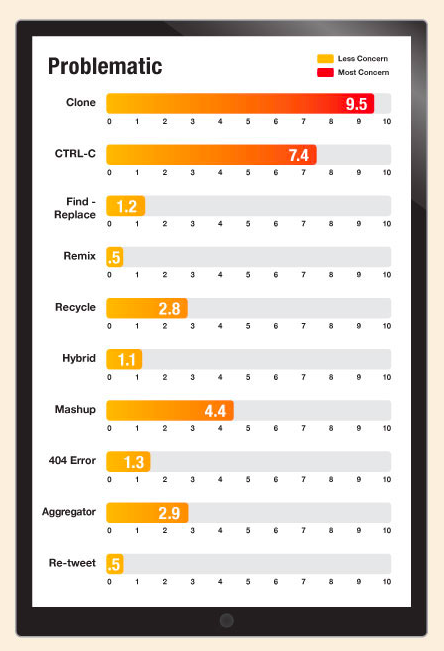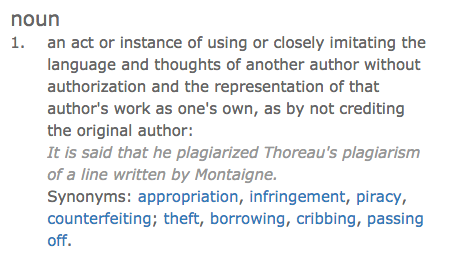After exactly 4 entries of fairly theoretical discussion around plagiarism, what it is, how it works, and how educators can shift their thinking with regards to it, I am very much looking forward to using this fifth and final entry to get down to brass tacks. All of this reflection and exploration is unquestionably important and necessary for stretching the culture of teacher attitudes toward student writers, but what does this literally mean for the classroom? How does this theoretical meandering translate into concrete strategies educators can use with their students to help build stronger and healthier writing skills in the academic disciplines? Well, I'm glad I rhetorically asked myself these questions, because several scholars smarter than I have already begun laying this very important groundwork and I am looking forward to reviewing a sampling of some of their ideas in this post. Below I have drawn together a compilation of strategies and ideas from the Council of Writing Program Administrator's best practices statement, Rebecca Moore Howard, Tricia Serviss, and Tanya K. Rodrigue's article on citation use, an interview with Rebecca Moore Howard and Sandra Jamieson, and Gottschalk and Hjortshoj's The Elements of Teaching Writing. Here is a synthesis and summary of some of the strategies they have been exploring.
Design and engage in assignments that are clearly defined, non-generic, and easy to understand.
- Explicitly state when and how each assignment will require students to draw on the ideas of others.
- "Avoid the use of recycled or formulaic assignments that may invite stock or plagiarized responses" (WPA Best Practices).
- "Start building possible topics early, ... giving students time to explore the topics slowly and helping them to narrow their focus" (WPA Best Practices).
- "Link the topics for research papers closely to the content of your course" (Gottschalk and Hjortshoj 120). It is difficult to find pre-written work on highly specific topics and students will be less likely to lean inappropriately on other work when they are discussing familiar material.
Facilitate a writing process that occurs over time; writing projects that are done in stages help students avoid procrastination, which Gottschalk and Hjortshoj believe is the primary reason for plagiarism.
- Assign pre-writing activities.
- Take time to review notes, drafts, and revisions that would show progress on a piece of writing over time.
- Require at least one draft of a works cited page before the final draft.
- Create opportunities for guided research using organizers and activities in order to teach students how to search for information that they will need to write well.
Instruct meaningfully on appropriately citing sources.
- Preemptively have a class discussion about common ways plagiarism misunderstandings can happen so that students know what to avoid.
- Cover all the different types of plagiarism, including examples, and why they are inappropriate.
- Provide accessible, regular support for students who have questions about sources, either through email, websites, or writing centers.
- Build in scheduled and facilitated time during the writing of an assignment for students to interact with you directly concerning their personal source attribution process, inviting questioning and clarification.
- When reading other works in the classroom, call attention to the works cited pages accompanying those pieces, indicating the importance and prevalence of demonstrating sources as well as the types of sources used by professionals.
Make it clear to students which sources are appropriate for use.
- Teach students how to evaluate which sources are reliable.
- Discuss what it means for a text to be peer-reviewed.
- Require a diverse array of source genres, including interviews, observations, surveys, in order to demonstrate how lively and complex research can be.
- Take time to instruct on library and research resources so that students are comfortable using them when needed.
Continue to build strong reading skills.
- The inability to interact meaningfully with a long or complex text makes it impossible for students to paraphrase or summarize. Strong readers will have less difficulty finding and using needed information.
- Summary is an advanced literary task in and of itself that can be practiced in the classroom before students need it to complete a paper.
Respond productively when instances of plagiarism do occur.
- Take the time to discuss the writing with the student in order to determine if the plagiarism is a result of deliberate intent to deceive.
- Ask students for documentation supporting the information they are using in their paper.
- Make the consequences for intentional plagiarism clear, predetermined, and consistent.
While this list isn't exactly a few quick bullets that can be easily memorized for classroom use, it is a potential place to draw from when brainstorming strategies that might work well in your classroom. Maybe only a few of these ideas seem useful to you; maybe none of them do. The important component of this series is not the above list. My goal with this series was simply to challenge the ways we currently think about and approach confusion around source use in the modern classroom. My hope would be that this blog series would be a infinitesimally small portion of a wider effort to dialogue more productively and open-heartedly about how to help students become smarter, stronger, and more sophisticated writers.





